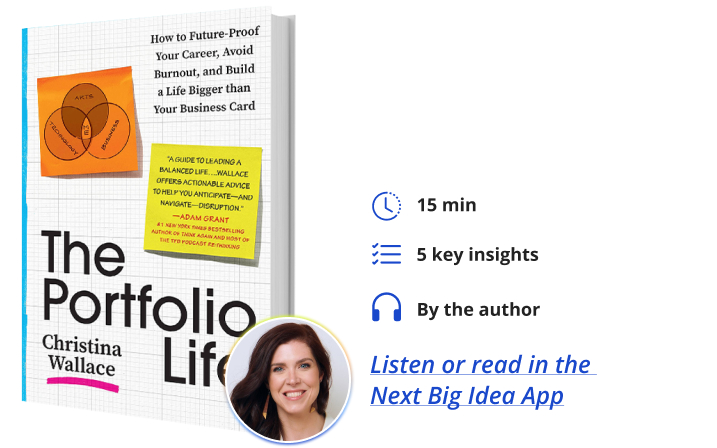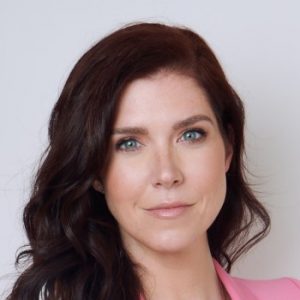Christina Wallace is a self-described “human Venn diagram” who has crafted a career at the intersection of business, the arts, and technology. She is currently a Senior Lecturer of Entrepreneurial Management at Harvard Business School and an active startup mentor and angel investor. She was a management consultant with the Boston Consulting Group and began her career at the Metropolitan Opera. Christina holds undergraduate degrees in mathematics and theater studies from Emory University and an MBA from Harvard Business School.
Below, Christina shares 5 key insights from her new book, The Portfolio Life: How to Future-Proof Your Career, Avoid Burnout, and Build a Life Bigger Than Your Business Card. Listen to the audio version—read by Christina herself—in the Next Big Idea App.

1. There’s no such thing as a right brain and a left brain.
Whether you first stumbled on this idea via a BuzzFeed quiz or had a teacher or parent introduce it, most people believe that humans are either analytical, language-driven thinkers (left-brained) or creative, big-picture thinkers (right-brained). Most people feel like this framework doesn’t quite fit them.
This theory is based on the lateralization of brain functions—that is, the brain contains two hemispheres, each performing specific roles. This left/right dichotomy is so well known that it’s often used as a shorthand for categorizing people. Except, like many supposed “facts” of pop psychology, it’s not true.
In the 1960s, doctoral student Michael Gazzaniga worked with neurobiologist Roger W. Sperry on a Caltech study of patients with epilepsy whose corpus callosum—a wide, thick nerve tract that connects the two hemispheres—was severed to prevent seizures from spreading across the brain. Without that bundle of nerve fibers connecting the two sides of the patients’ brains, the scientists were able to devise a way to show images to only one side of the brain or the other. One patient who had a square shown to his left hemisphere said he could see a box. But when the image was shown only to his right hemisphere, even though he could still see the image and point to it, he was unable to name it. As a result, Gazzaniga theorized that both hemispheres are involved in processing an image, though only the left hemisphere could articulate what it was since, as in this patient’s case, without communication from the left side, the right side couldn’t find the word for “box.”
While the main result of Gazzaniga’s research was to show how much the two sides needed to work together to carry out simple tasks, a 1973 New York Times Magazine article titled “We Are Left-Brained or Right-Brained” misinterpreted the results as “two very different persons inhabiting our heads.” Other publications picked up the story, and the myth of right-brained and left-brained people took hold. Neuroscientists have been trying to debunk this idea for more than fifty years, but the misleading framework persists.
So listen closely: You can be no more left-brained than left-lunged or left-kidneyed! Don’t worry that you don’t fit into a box that doesn’t actually exist, and instead embrace all of the things that make you you. Because really, we’re all human Venn diagrams.
2. Be your own BATNA (Best Alternative To a Negotiated Agreement).
BATNA is a term from the legal world that stands for the Best Alternative To a Negotiated Agreement. In other words: it’s a backup plan.
“A Portfolio Life offers four things: identity, optionality, diversification, and flexibility.”
Do you feel like “once-in-a-lifetime” disruptions seem to be happening every five to seven years? Wars, pandemics, bank collapses, recessions, world-altering climate disasters, world-altering technology advancements (hey there, GPT-4!)? It’s not in your head: monumental changes are coming faster and with greater impact than ever before. That means the playbook that worked for other generations just doesn’t apply anymore. How can you build a career—a life!—in a state of constant change? You’re going to need a backup plan, or several. Really: a portfolio of them.
A Portfolio Life offers four things: identity, optionality, diversification, and flexibility. Together, these four attributes give you backup plans in spades.
An identity beyond your job title means a layoff doesn’t mean you lose who you are. Optionality to pivot to a different industry or function means you never have to feel like your back is against the wall in a professional space that is contracting or going through an existential crisis. Diversification means you can weather the constant disruptions that have become the norm (technological, ecological, political, you name it). And flexibility to rebalance your life when your needs or goals change means you don’t have to figure out everything you’ll ever want or need and pick the right path for your entire life. You just have to form a strategy for now, for this season of life.
3. Give it 85 percent.
Have you ever been told to give 110 percent? Do you hate that idea as much as I do?
It’s pretty common in the startup world to be expected to work at your max capacity at all times. We do “sprints” and live tethered to our phones and somehow have normalized a level of work that basically ensures we all hit a point of burnout. That ethos has seeped out of startups (and finance, consulting, and big law) into every corner of our culture. This notion we should give our all—and then some—is in the water. It doesn’t feel sustainable, and that’s because it’s not.
“They intentionally leave 15 percent of their time unscheduled.”
Looking for alternatives, I turned to my operations management colleagues at Harvard Business School to see if there was research on the optimal level of working and stumbled across a surprising finding: the world’s best-run manufacturing lines run at 85 percent capacity. That’s facilities at the top of their game, who have worked out all the kinks and perfected their systems. They intentionally leave 15 percent of their time unscheduled. Why? Because planned downtime is cheaper than unplanned downtime.
Planned downtime means time for routine maintenance. It means space for do-overs when (not if) you make mistakes. It means there’s room for the surges that may come from time to time, and those surges won’t break you (or, say, cause you to burn out). It means acknowledging reality and leaving space for life rather than planning for only the best-case scenarios. Now I know we are humans and not manufacturing lines, but honestly that should make the case even stronger. We should see 85 percent as your target maximum, not some hypothetical 110 percent.
4. Rest is a requirement, not a reward.
There’s a big caveat in my book that I’m not afraid to put out there: when it comes to planned downtime, do as I say, not as I do. I was raised with a work ethic that was formed by scarcity, religion, exceptionalism, and the quintessential American narrative of bootstraps. As such, I have never found a five-minute window I couldn’t be productive in. Working, working, and more working is how I mitigate disasters and manage my anxiety (as well as fuel all of my interests and passions).
One of the big insights from my research was the imperative to include rest in your portfolio. To see it as a requirement, a key part of making your life sustainable, rather than a reward to be earned. Rest can and should come in small ways throughout your day and week and month. Rest is an opportunity to recharge and recover. It can also come in larger ways through intentional breaks like sabbaticals.
“Rest can and should come in small ways throughout your day and week and month.”
Research from my colleague DJ DiDonna of The Sabbatical Project suggests that sabbaticals may feel like a rich person’s solution to the modern problem of burnout and overwork, but they are actually a very old idea. He and his colleagues found “much more than an extended vacation, sabbaticals provide a psychological safe space to figure out what it means to live a more authentic life.” Perhaps surprisingly, they found that while many sabbatical-takers did make drastic changes afterward (like quitting a job or deciding to have kids), the majority simply returned to a version of their previous lives with a newfound, hard-won perspective.
5. Build a life bigger than your business card.
You are not your job.
The term “portfolio life” was first coined in 1989 by Charles Handy in his book The Age of Unreason. He bristled at the notion that your life’s work should be one narrowly defined job and instead argued it could be a collection of passions, interests, and hobbies. While his definition was still work-focused, I expand the definition of a portfolio life more broadly to include relationships, community, personal growth, and impact.
Your time is your scarcest resource, and a portfolio life demands more active stewardship of it than a linear life does. It’s not easy and it’s not particularly intuitive when you’ve been raised in a society that demands productivity above all else. It is worth developing the systems and structures to protect and invest your time in the pursuit of joy. You are more than the economic value of your labor, and the imprint of your life is far bigger than your business card.
The world is changing faster than ever before. In the midst of that change, it can feel daunting to aim for a life that is fulfilling, financially stable, and flexible enough to accommodate all of the dimensions of your human Venn diagram. It can also feel like a personal shortcoming when the playbook our parents and grandparents set out for us looks utterly impossible to follow. Yet you are entitled to build a life filled with joy, growth, love, adventure, beauty, and rest. Honestly, you should demand nothing less. Because it’s true: You do only live once.
To listen to the audio version read by author Christina Wallace, download the Next Big Idea App today:
































